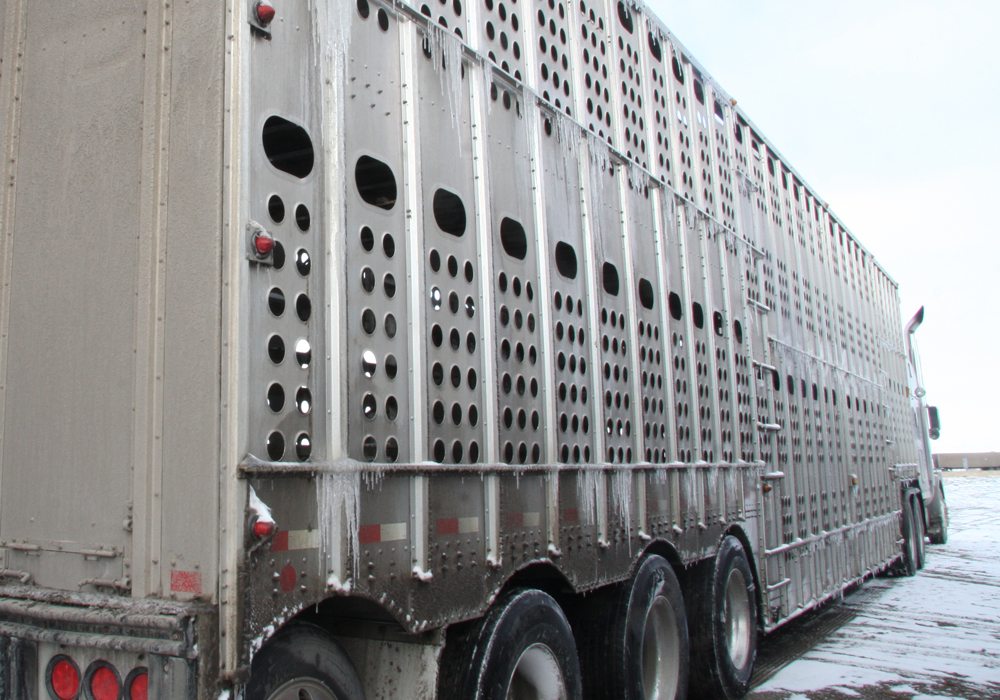Transportation of cattle can be a contentious public issue.
Alberta Farm Animal Care has released preliminary results of a compromised cattle benchmarking project in which the condition of animals arriving at auction markets, provincial abattoirs and a federal meat plant were evaluated for a year.
Led by Agriculture Canada researcher Karen Schwartzkopf-Genswein at the Lethbridge Research Centre, the project found between 79 percent and 98 percent of all cattle transported to auction or slaughter were fit for transport when seen arriving at the locations studied.
However, there are definite areas for improvement.
Read Also

Trump’s tariffs take their toll on U.S. producers
U.S. farmers say Trump’s tariffs have been devastating for growers in that country.
“We are never going to hit zero because stuff happens on transport, but we still have some room for improvement,” said Melissa Moggy at the Alberta Beef Producers annual meeting held in Calgary Dec. 4-6. Moggy was part of the research team.
A large body of research has focused on cattle transport and welfare, but there is not much information on the fitness of cattle arriving at auctions and abattoirs.
“Without this data we can’t know if we are doing a good job and if we aren’t, where do we need to improve?” she said.
The Canadian Food Inspection Agency has regulations and policies defining compromised and unfit animals. There is also a provincial animal protection act, or if needed, the Criminal Code of Canada may also be implemented.
“An unfit animal is not allowed to be transported for any reason other than for preventive treatment or diagnosis,” Moggy said.
“Compromised animals may be transported with special provisions.”
A compromised animal is one with reduced capacity to withstand transportation but where movement with special provisions will not lead to undue suffering. They may be locally transported for veterinary care, humane slaughter or euthanasia.
They may be compromised if they have imperfect locomotion, a slight limp or lameness that is not readily identified.
Unfit animals are vulnerable, and transportation could cause unreasonable suffering. An unfit animal has an obvious limp and inability to bear weight on any one leg. In more severe cases it may be unable to use a foot to walk or cannot stand or stay standing.
Observations took place at 10 provincial abattoirs, eight auctions and one federal plant.
The project considered age, cattle type, sex, body condition score and description of conditions that the animal may have had, as well as associated factors such as weather, group size, truck size and type, market conditions, trip distance and how the animal was disposed of.
At the auction markets they observed mature beef, mature dairy and beef and dairy feeders.
“An auction market is not an acceptable location for a compromised animal,” she said.
Among mature beef cows, 90 percent were fit for transport. About nine percent were compromised and .5 percent were unfit. Of that group, 60 percent had multiple problems.
Most of the beef and dairy feeders were fit.
Among bulls sent to market, 3.8 percent of mature beef bulls were compromised or unfit.
Mature dairy animals had the most problems. Among those considered compromised or unfit, 70 percent had multiple problems.
Observers saw animals with a body condition score of less than two, weakness and lameness while some were in heavy lactation and udders were dripping because they needed to be milked.
“These were conditions that we suggest auction owners and employees should concentrate on when they are looking at animals coming off the truck to assess these animals to make sure they are not exhibiting these conditions,” she said.
Those selling cull dairy cows need to think about where the animals are going and decide if they can stand up during transport because they could be travelling a long distance.
A greater proportion of compromised animals were observed at provincial abattoirs as they may only be transported to the nearest place for suitable care, or to be humanely slaughtered or euthanized.
The research team found that 75 percent of mature beef animals were fit to travel, while nearly 22 percent were compromised and slightly more than three percent were ruled unfit.
Among mature dairy cows, 16.67 percent were unfit while around 41 percent were considered compromised. The rest were fit.
The most common problems among the unfit dairy were thinness and severe lameness. However, researchers counted only seven dairy cattle at the abattoirs, so the actual levels of difficulty were very low.
About 12 percent of feeder cattle and 6.6 percent of dairy feeders showed signs of respiratory disease. About 7.5 percent of feeders were lame.
One federal abattoir was monitored. This plant did not buy dairy cows but the observers noted most of the mature beef cows arrived fit.
The report has identified challenges and made recommendations.
Compromised animals were being bought and resold at auction markets and were likely to be transported again.
Animals were left standing for long periods at auctions until they were transported to a new buyer or slaughter.
Interpreting regulations and determining whether an animal is unfit or compromised is a challenge so more clarity is needed.
“When you are in an auction market or an abattoir, you do not have time to go back and sit with your boss and decide if that animal is fit for transport or whether or not you should keep her or send her back,” she said.
Funding for this project was provided through Agriculture and Agri-Food Canada’s AgriMarketing Program, Assurance Systems, under the Growing Forward 2 (GF2) policy framework, a federal-provincial-territorial initiative, Alberta Beef Producers, Alberta Cattle Feeders and Alberta Milk.
Contact barbara.duckworth@producer.com
















